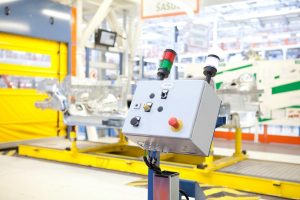In the realm of industry, machine vision (MV) is a form of technology and method used to provide imaging-based automatic inspection and analysis for such applications as process control and robotic guidance. It’s a term encompassing a large number of technologies, software and hardware products, integrated systems, actions, methods and expertise.
As a systems engineering discipline, machine vision is distinct from computer vision, as it attempts to integrate existing technologies in new ways and apply them to solve real world problems. Often times, the term is used in a broader sense, as it also encompasses products and applications associated with image processing.
Machine vision systems have been used for years to automate processes. Applications can range from checking the amount of fluid in bottles on production lines to inspecting the number and alignment of pins on a microchip or detecting flaws in fruit before it is packaged for shipping.
Most of these applications deal with tangible, defined measurements. As in bottle inspection, the camera system is triggered via a proximity sensor when the bottle is in front of the camera. The system looks for a transition in intensities to determine if the liquid in the bottle is in accordance with the specifications of the particular product.
In the automotive industry, machine vision is being used more frequently each year. For instance, the collision avoidance system, which detects an imminent front crash using optical sensors, radar, or a combination of the two, provides warning, braking, and/or steering systems to respond to the possible danger.
In the example of front crash warning systems, the computer is looking at objects that are static, however, the same technology is being used to predict the probability of a pedestrian stepping off a curb, or darting between parked cars. This concept can allow driver assistance systems to estimate when the driver is unlikely to notice a person, and could lead to less vehicle/pedestrian accidents.
Intelligent driver support systems hold promise to minimize accidents. With this type of system, the pedestrian could be detected, and predict the possibility of a collision, and then warn the driver or engage automatic braking or other safety features.
The demand for ‘smart surveillance’ monitoring systems is increasing. At locations like subways, airports, theme parks, machine vision systems are being installed to monitor movement of large crowds. Visual markers are used to describe the behavior of the crowds under different scenarios.
In any of the above modalities of using machine vision, each specification is carried out in the blink of an eye. At Universe Optics, we design and manufacture precision optical lenses to deliver the best optical solution for the application at hand. From the bottle that should not be over-filled, to the child running into the street, you can be assured that your lens will be designed to fit the exact need.
Faster hardware, more intelligent tools and better application software development will expand the use of machine vision in manufacturing processes and in the world in which we live.
Universe Kogaku designs and manufactures optical lenses for security, high tech and electronic applications. We stock 1000’s of standard lens assemblies and can custom design a solution for scanners, CCTV, CCD/CMOS, medical imaging, surveillance systems, machine vision and night vision systems.